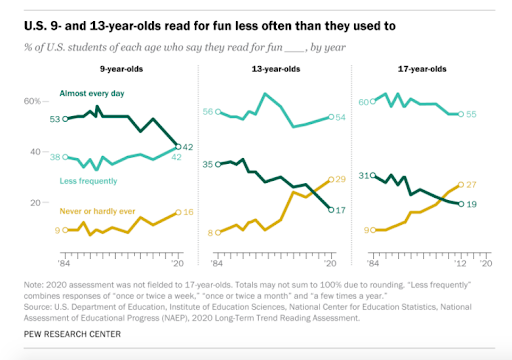Can Speech Recognition Technology Help Children Learn to Read?
March 7, 2022

As the world eagerly awaits the end of COVID-19, a new pandemic may well be underway. But this time, it’s an illiteracy one.
A recent UNESCO report revealed a sobering statistic. As many as 100 million children are expected to fall behind the minimum proficiency level in reading due to COVID-related school closures, erasing progress made over the past twenty years.
Looking at this and similar studies, one thing is clear: improving literacy and reading skills will be one of the most pressing challenges in education in the coming decades.
Speech recognition technology holds a lot of promise in this regard, but it comes with a caveat. As Dr. Patricia Scanlon, Founder and Executive Chair of SoapBox Labs, puts it:
“If you build speech recognition right, you can actually accelerate the system. If you build it wrong, you’ll make it worse.”
At SoapBox Labs, we take this problem to heart. In 2021, we partnered with Whiteboard Advisors, an education social impact agency, and set out to explore the current state of early literacy and the potential of speech technology for mitigating the global reading crisis — and how to do it right.
We sought the input of leading tech experts, education advocates, thought leaders, and policy makers. Their contributions and our research came together in a white paper, Can Speech Recognition Help Children Learn to Read?
Below, you can read the key takeaways from the white paper, check out up-to-date statistics on the reading crisis, and learn about our upcoming webinar that will dive deeper into this topic.
Let’s dive right in!
Illiteracy and reading proficiency inequity: A persisting problem
The coronavirus pandemic may have exacerbated but didn’t cause the global reading crisis.
Even before COVID, World Bank data showed that 53% of children in low- and middle- income countries couldn’t read and understand a simple text by age 10. In poor economies, that figure was as high as 80%.
This is what some researchers refer to as “learning poverty” — and it’s not exclusive to developing countries.

In 2019, well before the pandemic, the U.S. National Center for Education Statistics reported that only 35% of fourth-graders (external PDF) performed at or above the reading proficiency threshold. At the same time, the percentage of students who “never” or “hardly ever” read for fun has been on a steady rise since the early 1980s.

Things aren’t looking great in Canada, either. Deloitte reports that nearly one in four students in early primary school — almost one million children — fall short of reading goals.
Across the pond in the U.K., educators warn that a growing number of students start secondary school with the reading level of six-year-olds. In Australia, 24.9% of five-year-olds living in adversity have language difficulties, and most of them also exhibit pre-literacy difficulties.
The promise and challenges of speech recognition technology
Speech recognition software is among the most effective tools for fighting illiteracy and reducing educational inequity.
A mere 15–20 years ago, reading intervention programs with speech recognition capabilities would fail due to technical difficulties, low accuracy rates, and privacy concerns.
This is no longer the case. Recent technological advancements have ushered in a new generation of voice tech that can successfully take on the challenges raised by the global reading crisis.
As Margery Mayer, former President of Education at Scholastic and current adviser and board member of multiple education companies and non-profits, wrote for our white paper:
“In a few years, I have no doubt this technology will be part of every reading classroom, and educators will be able to say with certainty it accelerates reading skills in young students. Educators will find it enables them to be more strategic in their instruction. It’s an idea whose time has come.”
Here are three ways in which voice technology can have a positive impact on kids’ reading skills:
1. Enabling independent reading practice
Personalized reading instruction is time-consuming. Just 15 minutes of one-on-one reading practice per student in a class of 25 would eat up two-thirds of a teacher’s working day.
Voice technology can help address this problem — as well as chronic staff shortages and underfunding — by enabling kids to practice reading in their own time. The system prompts the child to read a passage aloud and returns feedback, corrections, and encouragement in real time.
Independent practice can also be a liberating experience for kids who struggle with reading aloud in front of others. Dan Cogan-Drew, Co-Founder and Chief Academic Officer at Newsela, noted for our white paper:
“There’s real interpersonal stress for a student who has difficulty reading and is reading to another person. In some cases, it’s really much better that you’re reading to a machine than a human, because the machine passes no judgment. It just says, ‘This is what I heard you say.’”

What to watch out for
A key priority here is to ensure the accuracy of speech recognition systems. The trouble is, most solutions on the market were developed using mature voice data sets and often struggle to understand kids.
Due to anatomical differences, young voices have different pitches than adult ones. Children use different vocabulary. They pause, stumble over words, over-elongate, and over-enunciate. On top of that, kids’ voices and speech patterns change as they develop. Accents, regional dialects, and ambient noise also vary widely.
These issues must be addressed. Otherwise, the system will return false positives or false negatives, which disrupt the learning process and do more harm than good.
To ensure high accuracy rates at SoapBox Labs, we developed our voice engine using kids’ voice data only. The tens of thousands of hours’ worth of recordings feature children aged 2–12 from 193 countries representing a wide range of accents and dialects. What’s more, we recorded the children in everyday settings with background noise to mimic how human speech and voice tech interact in real life.
2. Leveling up reading fluency assessments
A key use case of voice technology in education is reading fluency evaluation.
Speech recognition software can listen as children read and generate a detailed breakdown of key fluency indicators, including insertions, substitutions, deletions, repetitions, and words correct per minute.
This kind of hyper-detailed insight enables more accurate and objective feedback. It also improves teachers’ ability to track progress and identify learning opportunities, some of which may otherwise go unnoticed.
Last but not least, voice-enabled reading assessments are highly scalable and can be done more frequently than conventional assessments. Students can read the text independently, with teachers reviewing the system-generated reports in their own time.
What to watch out for
Once again, the challenge here is to ensure the accuracy of speech recognition and guarantee bias-free feedback. Gaining the trust of educators is also essential. Sean Ryan, President of McGraw Hill School Group, summed this up nicely:
“The primary determinant of mass adoption [of speech recognition] is trust, built one experience at a time, over time. I see this accelerating as teachers witness the time savings and, more importantly, gain deeper insight and drive positive student outcomes.”
3. Generating valuable longitudinal data
In addition to facilitating literacy practice and assessment, speech technology systems collect large volumes of high-quality data. It can be used not only to better understand where students need personalized instruction or intervention but also in formulating educational policies.
In the words of Dr. Martyn Farrows, CEO of SoapBox Labs:
“Over time, the data generated from speech recognition also provides longitudinal views for schools and districts and more informed product design decisions for EdTech companies.”
What to watch out for
Of course, the primary concern here is privacy. Kids speech recognition technology must never link collected data to unique profiles or identifiable individuals. Providers also shouldn’t sell, share, or use user data for marketing or advertising purposes.
At SoapBox Labs, we understand the importance of safeguarding children’s fundamental right to voice data privacy. As a privacy-by-design company, we take privacy rights into consideration at all stages of product design and engineering. We never sell, share, or use data collected in our voice engine to identify individuals or build user profiles.
Want to learn more about voice technology and literacy in preK-12 education?
Tune in to our free webinar Can Speech Tech Help Kids Learn to Read? on March 15 at 4 p.m. GMT for an exciting discussion on how voice technology can help fill learning gaps in a post-pandemic world.
Our panelists — a stellar team of education experts and voice tech advocates — will expand on the key takeaways of our educational white paper, discuss the history of speech recognition technology, and bring you up to speed on the latest advancements in the field.




